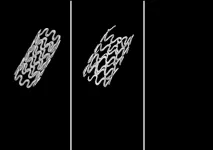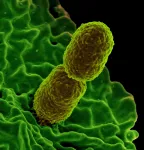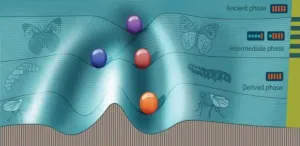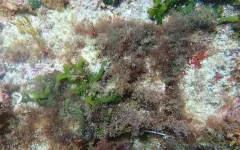(Press-News.org) HAMILTON, ON, Jan. 15, 2021 -- A team of neuroscientists and engineers at McMaster University has created a nasal spray to deliver antipsychotic medication directly to the brain instead of having it pass through the body.
The leap in efficiency means patients with schizophrenia, bipolar disorder and other conditions could see their doses of powerful antipsychotic medications cut by as much as three quarters, which is expected to spare them from sometimes-debilitating side effects while also significantly reducing the frequency of required treatment.
The new method delivers medication in a spray that reaches the brain directly through the nose, offering patients greater ease of use and the promise of improved quality of life, including more reliable, effective treatment.
Ram Mishra, a Professor in the Department of Psychiatry and Behavioural Neurosciences and Co-Director of McMaster's School of Biomedical Engineering, and Todd Hoare, a Canada Research Chair and Professor of Chemical Engineering, describe their research in a newly published article in the Journal of Controlled Release.
They and their co-authors Michael Majcher, Ali Babar, Andrew Lofts, and Fahed Abuhijleh have proven the concept of their new delivery mechanism in rats, using PAOPA, a drug commonly prescribed to treat schizophrenia.
A problem for patients using antipsychotic medications, Mishra explains, is that taking them orally or by injection means the drugs must pass through the body before they reach the brain through the blood. To be sure enough oral or injected medication reaches the brain, a patient must take much more than the brain will ultimately receive, leading to sometimes serious adverse side effects, including weight gain, diabetes, drug-induced movement disorders and organ damage over the long term.
When delivered through the nose, the spray medication can enter the brain directly via the olfactory nerve.
"The trick here is to administer the drug through the back door to the brain, since the front door is sealed so tightly," Mishra says. "This way we can bypass the blood-brain barrier. By delivering the drug directly to the target, we can avoid side effects below the brain."
Mishra and collaborator Rodney Johnson of the University of Minnesota had previously created a water-soluble form of the medication, which was used in the current research. The new form they created was easier to manipulate, but they still lacked an effective vehicle for getting it to the brain. A particular issue was that drugs delivered via the nose are typically cleared from the body quickly, requiring frequent re-administration.
Hoare, in the meantime, had been working with an industrial partner to develop the use microscopic nanoparticles of corn starch for agricultural applications.
The two scientists, who work across campus from one another, came together after researchers in their labs met at an internal McMaster conference. Two of the researchers, Babar and Lofts, worked on the project in both labs.
The engineering team was able to bind the drug to the corn starch nanoparticles that, when sprayed together with a natural polymer derived from crabs, could penetrate deep into the nasal cavity and form a thin gel in the mucus lining, slowly releasing a controlled dose of the drug, which remains effective for treating schizophrenia symptoms over three days.
"The cornstarch nanoparticles we were using for an industrial application were the perfect vehicle," Hoare says. "They are naturally derived, they break down over time into simple sugars, and we need to do very little chemistry on them to make this technology work, so they are great candidates for biological uses like this."
The gradual release means patients would only need to take their medication every few days instead of every day or, in some cases, every few hours.
INFORMATION:
The research work was funded by a Collaborative Health Research Partnership Grant (from the Natural Sciences and Engineering Research Council of Canada and the Canadian Institutes of Health Research) and McMaster University's Interdisciplinary Research Fund.
The researchers are seeking a corporate partner to move the technology into the marketplace.
Pediatric laryngotracheal stenosis (LTS), a narrowing of the airway in children, is a complex medical condition. While it can be something a child is born with or caused by injury, the condition can result in a life-threatening emergency if untreated.
Treatment, however, is challenging. Depending on the severity, doctors will use a combination of endoscopic techniques, surgical repair, tracheostomy, or deployment of stents to hold the airway open and enable breathing.
While stents are great at holding the airway open and simultaneously allowing the trachea to continue growing, they can move around, ...
There is currently no cure for osteoarthritis, but a group of scientists believe they've discovered a method through which a simple knee injection could potentially stop the disease's effects. These researchers showed that they could target a specific protein pathway in mice, put it into overdrive and halt cartilage degeneration over time. Building on that finding, they were able to show that treating mice with surgery-inducedknee cartilage degeneration through the same pathway via the state of the art of nanomedicine could dramatically reduce the cartilage degeneration and knee pain. These findings were published in Science Translational Medicine.
"Our lab is one of the few in the world studying epidermal growth factor receptor (EGFR) ...
The Gulf of Mexico holds huge untapped offshore oil deposits that could help power the U.S. for decades.
The energy super basin's longevity, whose giant offshore fields have reliably supplied consumers with oil and gas since the 1960s, is the result of a remarkable geologic past - a story that began 200 million years ago among the fragments of Pangea, when a narrow, shallow seaway grew into an ocean basin, while around it mountains rose then eroded away.
The processes that shaped the basin also deposited and preserved vast reserves of oil and gas, of which only a fraction has been extracted. Much of the remaining oil lies buried beneath ancient salt layers, just recently illuminated ...
MADISON, Wis. -- The demand for COVID-19 vaccines continues to outpace supply, forcing public health officials to decide who should be first in line for a shot, even among those in the same pool of eligible vaccine recipients.
To assist these efforts, researchers at the University of Wisconsin School of Medicine and Public Health and UW Health have developed a tool that incorporates a person's age and socioeconomic status to prioritize vaccine distribution among people who otherwise share similar risks due to their jobs. The tool helps identify those who are at greater risk of severe ...
WHAT:
Scientists studying the body's natural defenses against bacterial infection have identified a nutrient--taurine--that helps the gut recall prior infections and kill invading bacteria, such as Klebsiella pneumoniae (Kpn). The finding, published in the journal Cell by scientists from five institutes of the National Institutes of Health, could aid efforts seeking alternatives to antibiotics.
Scientists know that microbiota--the trillions of beneficial microbes living harmoniously inside our gut--can protect people from bacterial infections, but little is known about how they provide protection. Scientists are studying the microbiota with an eye to finding or enhancing natural treatments to replace antibiotics, which ...
A new study, led by a theoretical physicist at the U.S. Department of Energy's Lawrence Berkeley National Laboratory (Berkeley Lab), suggests that never-before-observed particles called axions may be the source of unexplained, high-energy X-ray emissions surrounding a group of neutron stars.
First theorized in the 1970s as part of a solution to a fundamental particle physics problem, axions are expected to be produced at the core of stars, and to convert into particles of light, called photons, in the presence of a magnetic field.
Axions may also make up dark matter - the mysterious stuff that accounts for an estimated 85 percent of the total mass of the universe, yet we have so far only seen its gravitational effects on ordinary matter. Even if the X-ray excess turns out not to be ...
Computer simulations of cells evolving over tens of thousands of generations reveal why some organisms retain a disused switch mechanism that turns on under severe stress, changing some of their characteristics. Maintaining this "hidden" switch is one means for organisms to maintain a high degree of gene expression stability under normal conditions.
Tomato hornworm larvae are green in warmer regions, making camouflage easier, but black in cooler temperatures so that they can absorb more sunlight. This phenomenon, found in some organisms, is called phenotypic switching. Normally hidden, this switching is activated in response to dangerous genetic or environmental changes.
Scientists have typically studied this ...
Scientists at the Institute of Physics of the University of Tartu have found a way to develop optical quantum computers of a new type. Central to the discovery are rare earth ions that have certain characteristics and can act as quantum bits. These would give quantum computers ultrafast computation speed and better reliability compared to earlier solutions. The University of Tartu researchers Vladimir Hizhnyakov, Vadim Boltrushko, Helle Kaasik and Yurii Orlovskii published the results of their research in the scientific journal Optics Communications.
While in ordinary computers, the units of information are binary digits or bits, in quantum computers the units are quantum bits or qubits. In an ordinary computer, information is mostly ...
Tsukuba, Japan - Out with the old, in with the new, as the New Year's saying goes, but not where the marine environment is concerned. Researchers from Japan have discovered that ocean acidification keeps algal communities locked in a simplified state of low biodiversity.
In a study published on 11th January 2021 in Global Change Biology, researchers from the University of Tsukuba have revealed that as oceanic carbon dioxide levels rise, the biodiversity and ecological complexity of marine algal communities decline.
Ocean acidification is the continuing increase in the acidity of the Earth's oceans, caused by the absorption of atmospheric carbon dioxide (CO2). ...
The celebrations in the 250th anniversary of the birth of Ludwig van Beethoven would not be the same without Herbert von Karajan's brilliant performances conducting Beethoven's memorable symphonies. The execution of any musical symphony is a hugely difficult task, demanding very significant skills on the part of each individual musician - but perhaps the most difficult task lies with the conductor who has to orchestrate the musicians into making the music cohesively come alive and speak to our deepest emotions.
In many ways the human brain is like an orchestra, where different regions perform very different types of processing, such ...







